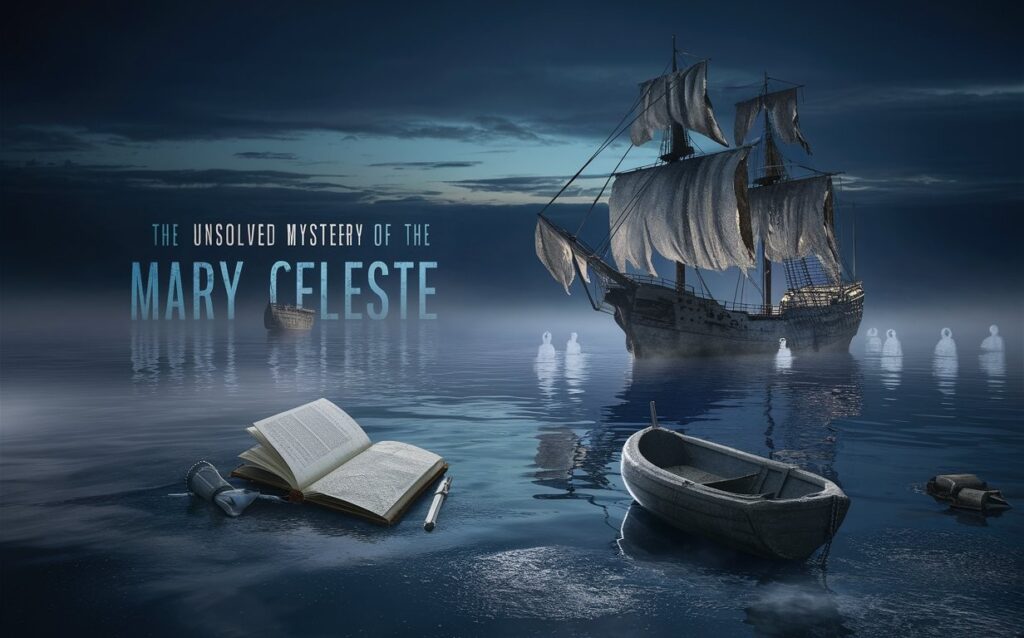The Unsolved Mystery of the Mary Celeste

The story of the Mary Celeste, a merchant ship found abandoned in the Atlantic Ocean in 1872, has intrigued historians, maritime experts, and armchair detectives for over a century. The mystery of the ship’s fate is one of the most enduring and enigmatic maritime puzzles in history. On a voyage from New York to Genoa, Italy, the Mary Celeste was discovered in perfect condition, drifting without a soul on board. The ship’s cargo, valuable goods, and personal items were all intact, yet the crew and captain had mysteriously vanished, leaving behind no clear explanation for their disappearance. To this day, the Mary Celeste remains an unsolved mystery that has sparked numerous theories, from plausible explanations to far-fetched speculations.
In this article, we will explore the background of the Mary Celeste, the events leading up to her discovery, and some of the most popular theories surrounding her disappearance.
The Voyage of the Mary Celeste
The Mary Celeste was a 282-ton brigantine, built in 1861 in Nova Scotia, Canada. She was originally named the Amazon and was primarily used as a cargo ship. By the time of her fateful voyage, she had been renamed the Mary Celeste and was under the command of Captain Benjamin Briggs, an experienced and respected sailor. The ship was carrying a valuable cargo of industrial alcohol, which was intended for Italy. Captain Briggs, along with his wife, Sarah, and their two-year-old daughter, Sophia, were aboard the ship along with a crew of seven.
On November 7, 1872, the Mary Celeste set sail from New York City bound for Genoa. All seemed well at the start of the journey, and there were no indications of any problems with the ship or its crew. However, by December 4, 1872, something went horribly wrong.
The Discovery: A Ghost Ship
On December 4, 1872, the Mary Celeste was spotted by the crew of the Dei Gratia, another ship that was traveling nearby. The Dei Gratia’s captain, David Morehouse, and his crew noticed the Mary Celeste drifting in the Atlantic, approximately 400 miles (640 km) off the coast of the Azores. The ship was eerily empty, with no sign of the crew or passengers. The sails were set, and the ship appeared to be in good condition—there was no sign of fire, piracy, or violent struggle.
Upon boarding the Mary Celeste, Captain Morehouse and his men found the ship in what appeared to be an almost perfect state. The cargo of industrial alcohol remained largely undisturbed, and the ship’s personal items, including the captain’s logbooks and personal effects, were still in place. The lifeboat was missing, but there were no signs of distress or any indication of why the crew would have abandoned the ship.
Further investigation revealed that the logbook had entries up to the day of the ship’s discovery, but the final entry was from about 10 days earlier, on November 25. The captain’s personal effects, including his logbook and papers, were found intact in his cabin, and the ship’s cargo—worth around $35,000 (an enormous sum at the time)—was still in place.
Despite the mystery, it was clear that the ship had not been subjected to a violent attack, nor was it a case of a natural disaster. The Mary Celeste was in remarkably good condition, considering it had been drifting for almost two weeks. Yet the disappearance of the crew and their families remained unexplained.
Theories Surrounding the Disappearance
The mystery of the Mary Celeste has spawned countless theories over the years. Some of these theories are based on logical reasoning and circumstantial evidence, while others venture into the realm of speculation and fantasy. Below are some of the most popular explanations:
1. Piracy Gone Wrong
One of the earliest theories was that the Mary Celeste was the victim of piracy. The missing crew and captain were presumed to have been taken hostage or killed by pirates. However, this theory does not hold up under scrutiny. There was no evidence of piracy—no signs of a struggle, no bloodstains, and no valuables were taken from the ship. Furthermore, the cargo was still intact, which would be unusual for pirates, who typically targeted valuable goods.
2. Mutiny
Another theory posits that the crew may have staged a mutiny. Some have suggested that Captain Briggs’ decision to bring his wife and child on board may have caused friction with the crew, leading to a rebellion. However, there is no evidence of mutiny. The ship’s log and the crew’s personal effects were left undisturbed, suggesting that they did not abandon ship under duress or in haste, as would be expected during a mutiny.
3. Natural Disaster or Explosion
One plausible theory is that the ship was damaged by a natural disaster or an accidental explosion. The Mary Celeste was carrying a cargo of industrial alcohol, and some have speculated that a leak in the cargo caused the ship to be filled with toxic fumes or an explosion, prompting the crew to abandon ship in a panic. However, this theory also has its weaknesses. If an explosion had occurred, there should have been more visible signs of damage to the ship, but the Mary Celeste showed no signs of such an event. Additionally, the cargo of alcohol was intact, ruling out an explosion caused by that.
4. Alcohol Fumes and Temporary Madness
One variation of the explosion theory suggests that fumes from the industrial alcohol may have caused the crew to abandon the ship temporarily. According to this theory, the vapors could have created a hazardous environment on board, leading the crew to believe that the ship was in danger of exploding. They may have fled in haste, taking the lifeboat, but never returned. However, this remains speculative, as there is no solid evidence of such fumes or an environmental hazard on board.
5. A Deliberate Abandonment
Some believe that the crew may have abandoned the ship for unknown reasons, perhaps believing it was no longer seaworthy. The missing lifeboat and the fact that no distress signals were sent have led to speculation that the crew left voluntarily, though it’s unclear why they would leave the ship in such good condition. If the crew left of their own accord, why didn’t they send a distress signal or leave any indication of their plans?
6. Supernatural Explanations
Over the years, the mystery of the Mary Celeste has also inspired numerous supernatural theories, including ghostly hauntings, alien abductions, or curses. These ideas, while intriguing, are not supported by any evidence and are widely considered speculative and fantastical. However, the eerie nature of the ship’s discovery—the absence of crew members and the pristine condition of the ship—has led some to imagine more paranormal explanations.
The Legal Investigation and Conclusion
After the discovery of the Mary Celeste, an inquiry was held to investigate the disappearance of the crew. The inquiry, however, was inconclusive. The ship’s insurance company initially suspected foul play and began an investigation, but no concrete evidence of piracy, mutiny, or other criminal activity was found. The investigation ultimately concluded that the crew had abandoned the ship, but the reasons for their actions remained unknown.
Captain Morehouse of the Dei Gratia, who found the Mary Celeste, was later awarded a financial reward for his discovery of the ship, but the mystery continued to haunt maritime history. To this day, the case remains one of the greatest unsolved mysteries in nautical lore.
The Legacy of the Mary Celeste
Despite the lack of resolution, the legend of the Mary Celeste endures in popular culture. It has inspired countless books, movies, documentaries, and articles, and remains one of the most famous maritime mysteries in history. The abandoned ship, its intact cargo, and the vanished crew continue to captivate the imagination of those fascinated by the unknown.
The Mary Celeste is a haunting reminder of the vast, mysterious expanse of the ocean, where even the most seemingly inexplicable disappearances can occur. Whether a result of human error, natural disaster, or something more mysterious, the mystery of the Mary Celeste persists as one of the great unanswered questions of maritime history.
Conclusion
The mystery of the Mary Celeste is a perplexing and chilling tale that has baffled investigators and enthusiasts for more than 150 years. Despite numerous theories and speculation, the true fate of the ship’s crew remains unknown. Was it a case of natural disaster, piracy, or something else entirely? The lack of concrete evidence ensures that the story of the Mary Celeste will continue to be one of the most enduring and intriguing maritime mysteries for generations to come.



Post Comment